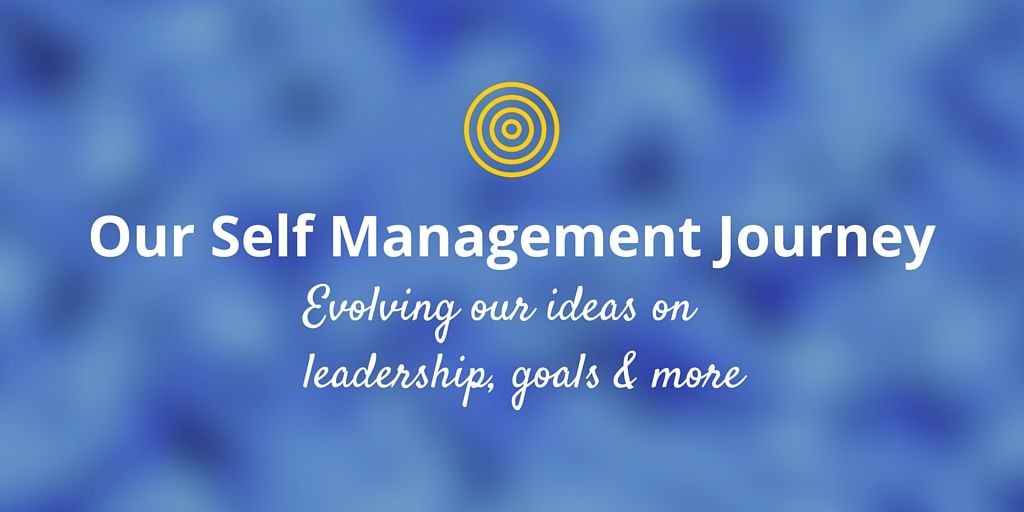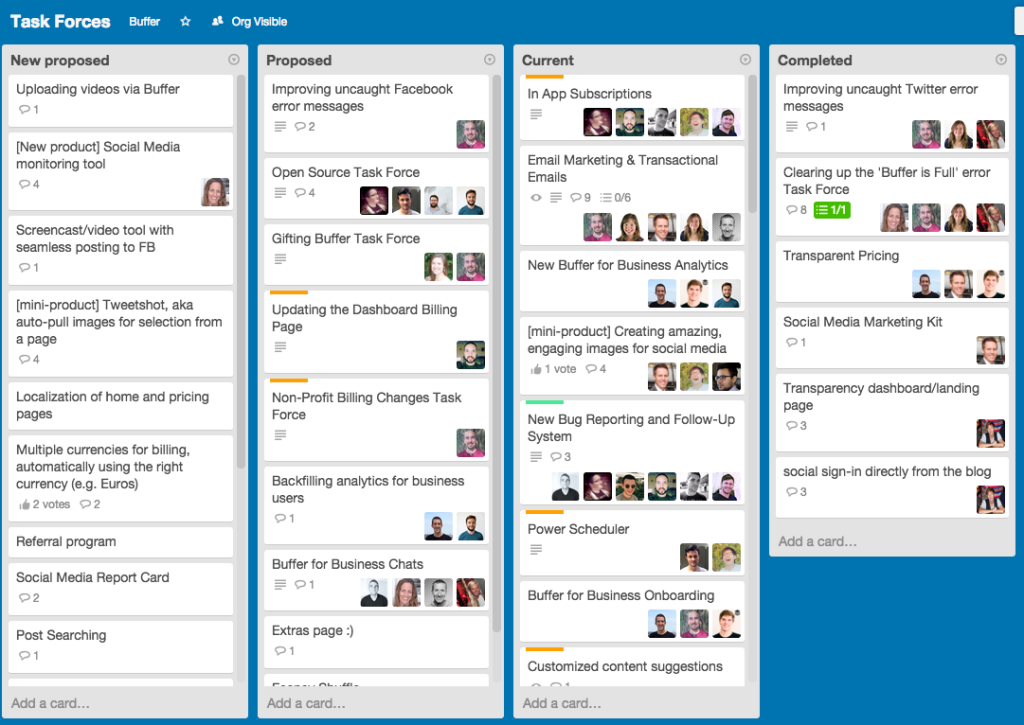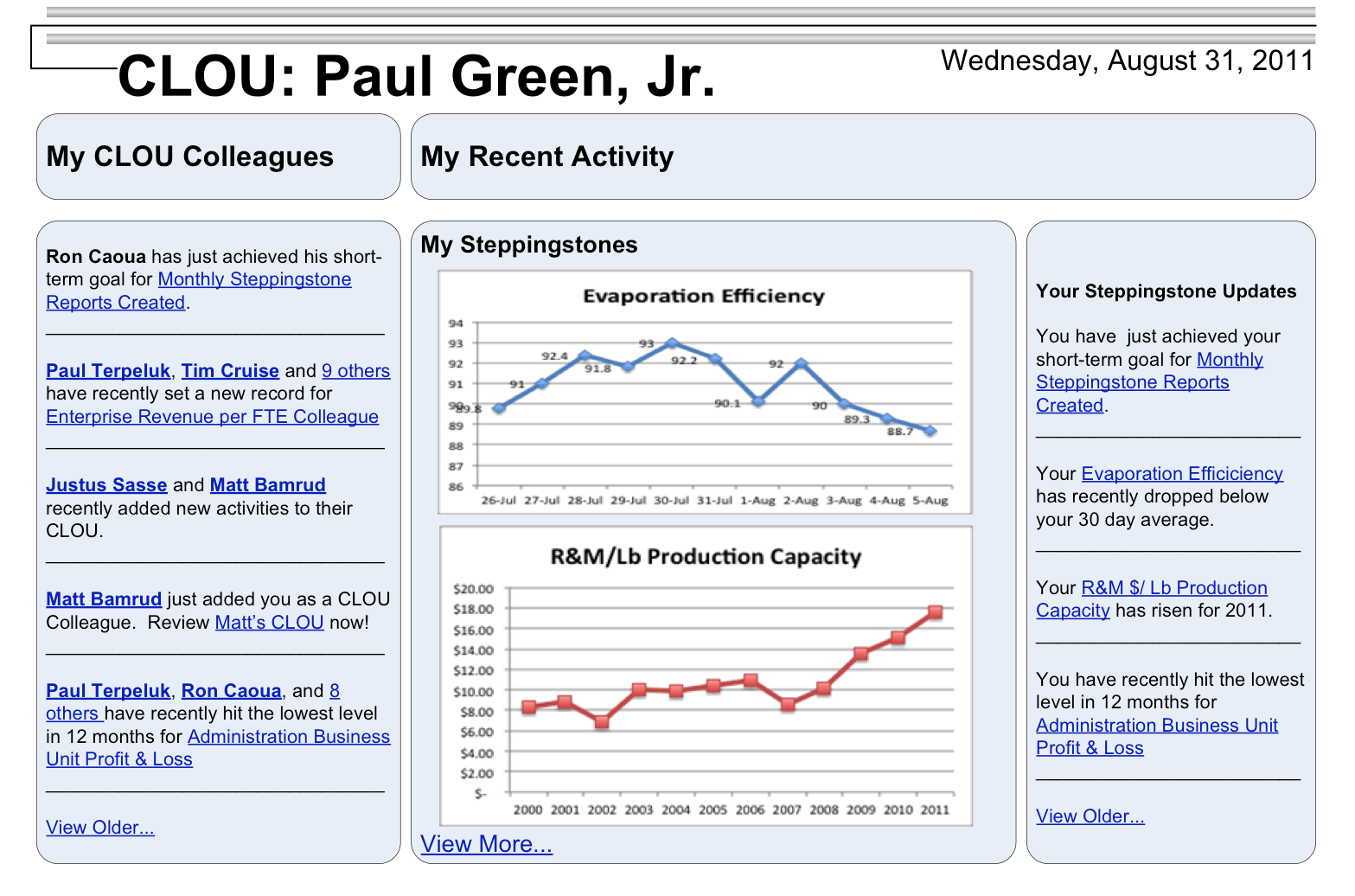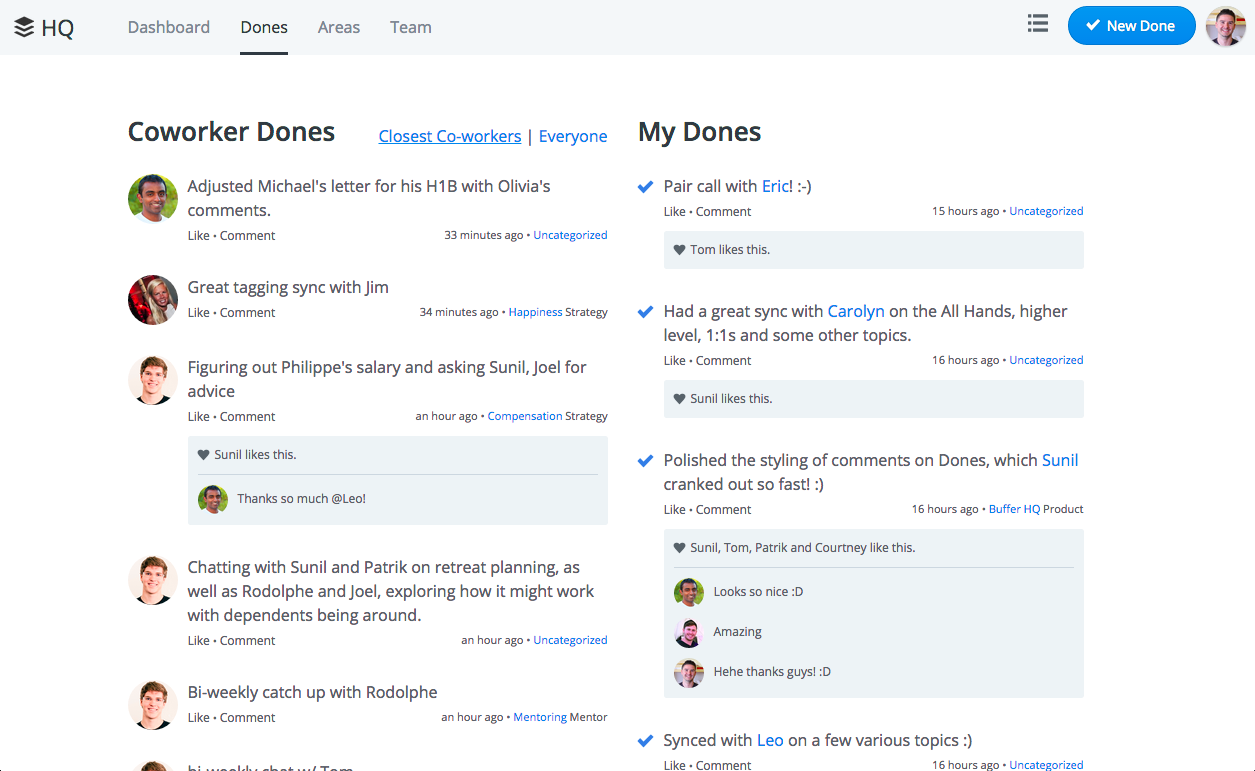Self-management was a bold and unique experience that we’re glad to have tried at Buffer. We learned a lot! Here are some of our self-management lessons as well as our current approach with natural hierarchy.
When I got my first job, it never occurred to me that there was more than one way to work. You went to an office, followed directions from a boss for 8-ish hours, and then went home.
That’s not quite how Buffer does things. During the time I’ve been lucky enough to be on board, we’ve experimented seemingly every day with new elements of work that once seemed immutable: titles and no titles, managers and no managers, office and no office.
We don’t work on a fixed schedule or from a fixed location. We generally don’t give or take orders, instead favoring collaboration and consensus.
The move to self management
So when we stumbled upon the book Reinventing Organizations by Frederic Laloux, we were intrigued. Scratch that, we were enamored—so much so that the entire team voted and agreed to become self-managed. So much so that we gave away more than 300 copies of the book so others could feel as inspired as we had.
We made a lot of changes, including dropping all titles, stopping all official coaching and mentorship, and letting each teammate choose the goals and projects they wanted to work on (and what they wanted to pay themselves). On the marketing side, we tried to create a marketing plan without any goals.
It was a unique time to be at Buffer, to say the least.
Fast forward to present day, and things feel a bit different. We’ve brought back coaching and mentorship, we’re more metrics-focused than we’ve ever been before.
We haven’t exactly defined what we are now. Are we still Teal (in the parlance of Reinventing Organizations)? Are there degrees of self-management?
How do we work today? What exactly are we doing?
I decided to go to the source and sat down with Buffer cofounders Joel and Leo for a chat on the triumphs and challenges of self-management.

Recalibrating from ‘overwhelming freedom’
“We learned a lot from the Teal experiment,” Joel said. “We discovered that quite a few things should change based on what we learned there.”
And from Leo: “The way I would describe it is that the amount of freedom people had, with absolutely no guidance, expectations or accountability, was pretty overwhelming.”
Some key elements that have changed over the course of the experiment include elements of structure, leadership and mentorship.
Leadership: Bringing back mentorship
One big catalyst for reexamining Teal was the departure of our former teammate Brian, who now works at Facebook. Before he left, he shared with Joel and Leo that he hadn’t been feeling as challenged and pushed toward growth as he previously had been.
“He said he felt like in the first year he learned more than the previous 15, and in the second year he didn’t learn that much,” Joel said.
After learning this, Joel and Leo chatted with many different teammates to discover that, generally, “people felt quite lost,” Joel said. “We learned that they appreciate the one-on-ones that we used to have and mentioned the guidance a lot.”
As a result, we brought back one-on-one mentoring meetings with a slightly different structure—instead of performance updates, it’s become a more open-ended way to work through challenges, get advice and brainstorm together.
Structure: Trading task forces for long-term teams
An even bigger change was in the structure of the way we work together.
During the Teal experiment, we moved away from long-term teams, instead opting for fluid task forces formed for a specific purpose and then disbanded.
Any teammate could propose a task force, and choose which task forces to be part of, and the sum of that is what made up their role. Here’s a look at some of our task forces during this time:

These roles could be across completely different areas of work, for example someone could be an engineer in a few product development task forces, but could equally be part of a customer service task force or a hiring task force.
We quickly discovered that our large variety of task forces across many different areas could become a bit confusing and overwhelming, and it was often tricky to figure out who was responsible for what on each task force, who would push things forward.
After Joel and Leo talked with many teammates to discuss their role, vision, goals, and commitments to the team, we started to transition away from the task force model and back to more stable, long-term teams.
“We learned how much people enjoy having more structure, and that structure and hierarchy are not the same thing,” Joel said.
Re-prioritizing goals and metrics
During Buffer’s Teal period, we let go of most accountability in terms of personal metrics. Basically, the idea was that everyone one the team is smart and is already making many smart choices in their personal lives, so they can be trusted to make great decisions at work.
Here’s how Reinventing Organizations puts it:
“People don’t need pressure from above, but they still need to get a sense of whether they are doing well. Teal Organizations measure indicators like team results, productivity, and profit, just like other organizations— except that they mostly tend to do so at the level of teams or process steps, and they don’t bother to measure individual performance (contrary to Orange Organizations that believe in individual incentives and therefore need individual metrics). The data is made public for all to see, creating emulation, a healthy form of peer pressure.”
Looking back, it seems we went a little overboard to throw all metrics out the window–even the ones that could help us get a sense of how we were doing and create that healthy emulation.
During this time, our team didn’t grow very much, and our Happiness response time numbers—one element that we tracked religiously in the past—got worse.
As we’ve transitioned to a more data-driven philosophy on the marketing side, it’s been interesting to see the results of our “year without goals.” Not a lot of growth occurred on the blogs, and on the social media side, we saw a bit of a decrease in our numbers.
Was it because we weren’t motivated? Reflecting on this time period, I do feel a different mindset was present. It’s tough to be motivated in a vacuum, where it feels as if any action you might take is as good as any other. It feels great to return to metrics for context and wayfinding.
Accountability=fun
A change that’s quite related the above goals and metrics area is a return to more accountability.
Simply put, we’ve discovered that more accountability is more fun. Accountability is a powerful intrinsic motivator to make stuff happen, and pretty much all of us at Buffer believe in the power of making stuff.
One big change that led the way here was Joel and Leo’s conversations with leaders at Zappos and their discovery of the Morning Star Self-Management Institute (the company Morning Star is heavily featured in Reinventing Organizations for their inventive un-management practices).
“That’s when we started to apply a lot more structure and discipline to things, trying to find the right way to structure ourselves,” Joel said.
Every year, each Morning Star employee negotiates a Colleague Letter of Understanding (CLOU) with those most affected by her or his work. A CLOU acts as the operating document for reaching one’s work goals. It makes explicit all of a teammate’s relevant performance metrics and can span as many as 30 different areas.

You can see a bit of the influence of the CLOU model in Buffer’s new internal tool HQ, which has been a big way of bringing accountability back to Buffer.


Said Joel: “We learned from Morning Star and others that you can have a lot of structure and still be very autonomous.”
One big change we kept: The element of wholeness
One element of self-management that we’re so grateful to have discovered is that of wholeness.
This is the belief that we should be not only allowed but encouraged to bring our full self to work, including our passions and strengths, flaws and vulnerabilities. As Laloux describes it:
“We are all of fundamental equal worth. At the same time, our community will be richest if we let all members contribute in their distinctive way, appreciating the differences in roles, education, backgrounds, interests, skills, characters, points of view, and so on.”
It’s something that feels obvious and simple, and yet is often surprisingly hard to do. Here’s how Laloux describes it:
“Showing up whole feels risky. We put out our selfhood for all to see, and expose this most treasured part of ourselves to potential criticism, ridicule, or rejection.”
Wholeness has allowed the team to know one another on a deeper, truer level. It’s given us a great lens for thinking on topics of diversity and inclusivity, and paved the way for us to grow in our capacity for understanding and empathy. Moreover, Buffer benefits from the full range of skills of each team member.
What we misunderstood about self-management
So it seems we’ve undergone a pretty big organic shift. We kept one element of self-management, as we were defining it, and changed 4 really big elements.
Did Teal fail, or did we fail to interpret Teal (as many do)?
“I feel like I’m more on the side of us misinterpreting it,” said Leo, who has written lots more about exactly how we misinterpreted it.
Joel agreed, adding that “We interpreted Teal as completely loose: the chaos, the forest. We threw out the ideas of management, skills, leadership, experience. Those are some of the things that that we got wrong.”
“We almost did something else, not even Teal. Maybe we got a little bit more into the rainbows and unicorns aspects of teal and didn’t realize it. I think it was a great learning experience; it did set us back,” Joel said.
What’s fascinating to think about is that there are parts of the Teal philosophy that we’re still fully on board with, like wholeness, and many other elements—like our values and respect for each teammate’s unique work style and schedule—that were naturally part of Buffer before we even knew what Teal or self-management were.
“Maybe what we had before Teal is quite Teal,” Joel mused. I think he might be on to something.
Where we are now
So what do we call the spot we’re in now? We still don’t have actual managers, although we have seen the emergence of natural leaders, high-level thinking and coaching and feedback.
“I don’t think we set out to become any specific thing, but every week we sense the changes that should happen. For the rest of the team, it might not feel right to say we’re still Teal,” Joel said. “In some ways it feels like such a step away from how it used to be; there was so much more freedom. It feels a bit disingenuous to say it’s still Teal.”
So are we a naturalized hierarchy? Teal light?
Our journey to self-management hasn’t been a straight path. In fact, sometimes it looks more like a circle, pointing us back to where we’ve been and helping us recognize it in a new light.
“We’re just what we want to be,” said Joel. “It’s great that we’ve set ourselves up to do the experiments, and we probably will still do more in the future.”
It’s exciting to know that the way we work now might not be the way we work next month, or next year.
Our journey might not have an estimated arrival time, but we have the ability to invent and re-invent work together, every day.
Have you experimented with unique work structures like self-management, holacracy, flat organizations or others? How did the experience feel for you?
We’d love to hear your thoughts on self-management or any other workplace structure in the comments!
Try Buffer for free
190,000+ creators, small businesses, and marketers use Buffer to grow their audiences every month.



